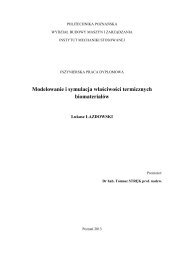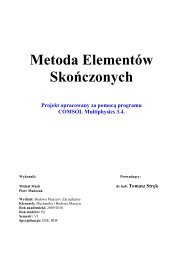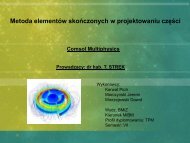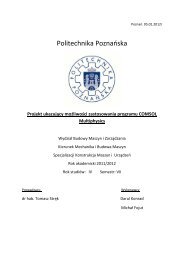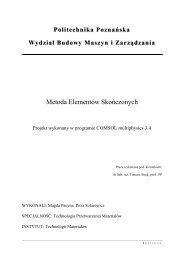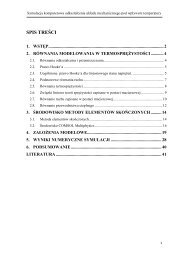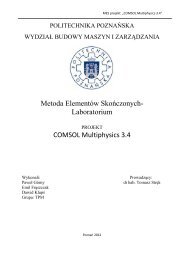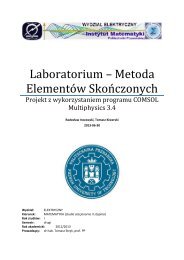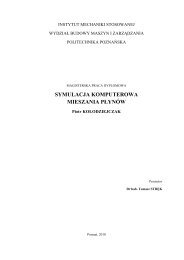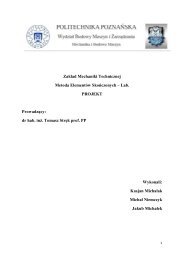Lithium-Ion Battery Simulation for Greener Ford Vehicles
Lithium-Ion Battery Simulation for Greener Ford Vehicles
Lithium-Ion Battery Simulation for Greener Ford Vehicles
Create successful ePaper yourself
Turn your PDF publications into a flip-book with our unique Google optimized e-Paper software.
AUTOMOTIVE<br />
FORD MOTOR CO., DEARBORN, MICHIGAN<br />
motive industry. The nickel used in these<br />
batteries is lighter than lead, helping<br />
the battery deliver twice the power output<br />
<strong>for</strong> the weight as lead-acid batteries.<br />
All of <strong>Ford</strong>’s HEVs on the road today use<br />
NiMH batteries.<br />
“Technological advances in NiMH batteries<br />
at the cell level are responsible <strong>for</strong><br />
much of the evolution of the pack design<br />
from the <strong>Ford</strong> Escape to the <strong>Ford</strong> Fusion.<br />
But these advances constituted the last<br />
of the ‘low-hanging fruit’ <strong>for</strong> NiMH,” explained<br />
Dr. Bernardi. Since automakers<br />
already believe they have tapped most<br />
of the potential of NiMH technology in<br />
HEVs, they are now moving toward the<br />
use of lithium-ion (Li-ion) technology due<br />
to its higher energy density, higher power<br />
density, and potential cost savings.<br />
The <strong>Lithium</strong>-<strong>Ion</strong> Advantage<br />
Li-ion batteries are commonplace<br />
in the world of consumer electronics.<br />
They’re lighter and more energy dense<br />
than other types of batteries, making<br />
them ideal <strong>for</strong> laptop computers, mobile<br />
phones, and other portable devices.<br />
For use in HEVs, Li-ion battery packs<br />
offer a number of advantages over the<br />
Particle Dimensionless Radial Distance<br />
Cu foil<br />
Negative<br />
Sep.<br />
Dawn Bernardi, Ph.D., is a battery research engineer<br />
with <strong>Ford</strong> Motor Company in Dearborn, MI.<br />
NiMH batteries that power today’s hybrid<br />
vehicles. In general, they are 25-<br />
30% smaller and 50% lighter, making<br />
them easier to package in a vehicle, and<br />
can be tuned to increase power to boost<br />
acceleration or to increase energy to extend<br />
all-electric driving distance. “The<br />
hybrid-electric vehicle is the next frontier<br />
<strong>for</strong> the lithium-ion battery. To the<br />
Positive<br />
Al foil<br />
Figure 4. <strong>Simulation</strong>s of lithium concentration throughout all particle locations within the positive electrode<br />
during after 40 seconds of a 10C discharge pulse [see Figure 2]. Regions denoted “Positive,” “Sep.,”<br />
and “Negative” correspond L neg , L sep , and L pos , respectively in Figure 1. The color scale from deep red to<br />
deep blue is associated with highest and lowest lithium concentration. <strong>Simulation</strong> results were obtained<br />
using COMSOL 3.5a.<br />
user, all these advantages could translate<br />
to better fuel economy at lower vehicle<br />
cost,” said Dr. Bernardi.<br />
Intensive development work is now<br />
underway to prove-out Li-ion technology<br />
<strong>for</strong> the auto industry, and <strong>Ford</strong> is<br />
using its extensive experience in BEVs,<br />
PHEVs, and HEVs to test the technology<br />
rigorously <strong>for</strong> its critical role in highvolume<br />
electrified vehicles of the future.<br />
“At <strong>Ford</strong>, we believe lithium-ion batteries<br />
have incredible potential <strong>for</strong> the next<br />
generation of electrified vehicles, and<br />
we’re already using lithium-ion technology<br />
in test units <strong>for</strong> the battery-electric<br />
vehicles that are part of our new electrification<br />
strategy,” said Ted Miller, senior<br />
manager of energy storage strategy and<br />
research at <strong>Ford</strong> Motor Company. “There<br />
are still technical challenges to make lithium-ion<br />
technology work in high-volume<br />
automotive applications and we are working<br />
hard to address those.”<br />
Modeling and <strong>Simulation</strong><br />
To design af<strong>for</strong>dable, fuel-efficient<br />
HEVs, manufacturers require a complete<br />
understanding of battery life and per<strong>for</strong>mance<br />
characteristics. For example, an<br />
automobile is expected to have a 10- to<br />
15-year lifespan, so researchers at <strong>Ford</strong><br />
need to ensure that new battery designs<br />
are going to last that long as well. For<br />
work in this arena, modeling and simulation<br />
is invaluable.<br />
“In order to know that the battery is<br />
going to last the life of the vehicle, we’d<br />
have to do at least 10-years worth of testing.<br />
But under our accelerated product<br />
development, we don’t have 10 years to<br />
put out a vehicle; we have maybe 3 to<br />
4 years,” explained Dr. Bernardi. “In a<br />
sense, modeling and simulation allow<br />
us to go into a time machine — fast<strong>for</strong>warding<br />
into the future — to help us<br />
determine how a battery will per<strong>for</strong>m after<br />
150,000 miles based on data that we<br />
have right now. It helps us make better<br />
decisions with less test time.”<br />
Batteries themselves are complex devices,<br />
with behavior that is governed by<br />
a multitude of interdependent physical<br />
effects and chemical processes (see sidebar<br />
on page 11). Batteries <strong>for</strong> automotive<br />
propulsion are even more complicated be-<br />
1 0 // C O M S O L N E W S 2 0 1 1<br />
➮<br />
Cov ToC + – A<br />
➭<br />
08-11 CN <strong>Ford</strong> 2011.indd 10 5/13/11 9:58 AM



